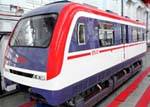China Builds Magnetic Train with Own TechnologyThis achievement claims China the third country in the world following Germany and Japan to gain the technology of magnetic suspension train, which uses powerful magnets to hold a train a few millimeters from the track and propel it with little noise or vibration. "It can run at an hourly speed of 60 kilometers, with the maximum 100 kilometers per hour during trial runs," said Ma Shukun, CPCP president. The CPCP is confident it can raise the speed in the future, said Ma, adding that engineers are preparing for tests of 300 to 400 kilometers per hour. Early this year, a German consortium, Transrapid International (TRI), won a lucrative contract to construct a high-speed magnetic suspension train for a 30-kilometre (19-mile) line in Shanghai connecting the Pudong airport to the downtown area. With a total investment of 8.9 billion yuan (1.07 billion US dollars), the magnetic levitation train system is considered a key project in Shanghai's Tenth Five-Year Plan (2001-2005). While the magnetic train is likely to play an important role in transportation, China has said it would rather see such a project built with domestic technology. The train carriage developed by the CPCP is a result of cooperation between the Zhuzhou Electricity-Powered Locomotive Research Institute in Hunan province and the Southwest China Jiaotong University in Sichuan province. According to sources from the CPCP, the train car, 11.2 meters long and 2.6 meters wide, can hold 28 seats with carrying capacity of two tons. The car, with its framework made of aluminum alloy, weighs 16 tons. It can run on an electromagnetic cushion of about eight to ten millimeters to make the travel safe, smooth, and noiseless, said the sources. The train will soon be put into regular operation after passing a comprehensive examination in Chengdu, capital of Sichuan province. A magnetic suspension train is based on the principle of increasing speed by reducing the friction encountered by standard wheels-and-rail transport, sending trains zipping along on an electromagnetic cushion. China has accelerated its research on manufacturing magnetic levitation trains and high-temperature superconductivity in recent years. |
| People's Daily Online --- http://english.peopledaily.com.cn/ |
